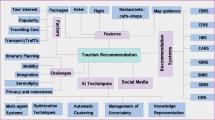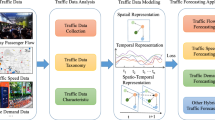Abstract
Travel time estimation (TTE) is an important research topic in many geographic applications for smart city research. However, existing approaches either ignore the impact of transportation modes, or assume the mode information is known for each training trajectory and the query input. In this paper, we propose a multi-task learning model for travel time estimation called MTLM, which recommends the appropriate transportation mode for users, and then estimates the related travel time of the path. It integrates transportation-mode recommendation task and travel time estimation task to capture the mutual influence between them for more accurate TTE results. Furthermore, it captures spatio-temporal dependencies and transportation mode effect by learning effective representations for TTE. It combines the transportation-mode recommendation loss and TTE loss for training. Extensive experiments on real datasets demonstrate the effectiveness of our proposed methods.



Similar content being viewed by others
References
Chen X, Xu J, Zhou R, Zhao P, Liu C, Fang J, Zhao L (2020) S2r-tree: a pivot-based indexing structure for semantic-aware spatial keyword search. GeoInformatica 24(1):3–25. https://doi.org/10.1007/s10707-019-00372-z
Endo Y, Toda H, Nishida K, Kawanobe A (2016) Deep feature extraction from trajectories for transportation mode estimation. In: Bailey J, khan L, washio T, dobbie G, huang JZ, Wang R (eds) PAKDD, vol 9652. Springer, Lecture Notes in Computer Science, pp 54–66
Gruslys A, Munos R, Danihelka I, Lanctot M, Graves A (2016) Memory-efficient backpropagation through time. In: NIPS2016, pp 4125–4133
He K, Zhang X, Ren S, Sun J (2016) Deep residual learning for image recognition. In: IEEE Computer Society CVPR 2016, pp 770–778. https://doi.org/10.1109/CVPR.2016.90
Hofleitner A, Herring R, Abbeel P, Bayen A M (2012) Learning the dynamics of arterial traffic from probe data using a dynamic bayesian network. TITS 13(4):1679–1693. https://doi.org/10.1109/TITS.2012.2200474
Ioffe S, Szegedy C (2015) Batch normalization: Accelerating deep network training by reducing internal covariate shift. In: ICML, pp 448–456
Jenelius E, Koutsopoulos H N (2013) Travel time estimation for urban road networks using low frequency probe vehicle data. Transp Res B Methodol 53:64–81
Kingma D P, Ba J (2014) Adam: A method for stochastic optimization. arXiv:1412.6980
Kisialiou Y, Sr IG, Laporte G (2018) The periodic supply vessel planning problem with flexible departure times and coupled vessels. Comput OR 94:52–64
Krizhevsky A, Sutskever I, Hinton GE (2012) Imagenet classification with deep convolutional neural networks. In: NIPS, pp 1106–1114
Li Y, Fu K, Wang Z, Shahabi C, Ye J, Liu Y (2018) Multi-task representation learning for travel time estimation. In: KDD. 1695–1704, vol 2018. https://doi.org/10.1145/3219819.3220033
Lv Z, Xu J, Zheng K, Yin H, Zhao P, Zhou X (2018) LC-RNN: A deep learning model for traffic speed prediction. In: Lang J (ed) IJCAI 2018, ijcai.org, pp 3470–3476. https://doi.org/10.24963/ijcai.2018/482
Mikolov T, Sutskever I, Chen K, Corrado GS, Dean J (2013) Distributed representations of words and phrases and their compositionality. In: NIPS, pp 3111–3119
Qian Z, Xu J, Zheng K, Zhao P, Zhou X (2018) Semantic-aware top-k spatial keyword queries. World Wide Web 21(3):573–594. https://doi.org/10.1007/s11280-017-0472-y
Rahmani M, Jenelius E, Koutsopoulos H N (2013) Route travel time estimation using low-frequency floating car data. In: ITSC 2013, pp 2292–2297. https://doi.org/10.1109/ITSC.2013.6728569
Rasmus A, Berglund M, Honkala M, Valpola H, Raiko T (2015) Semi-supervised learning with ladder networks. In: NIPS, pp 3546–3554
Shang S, Ding R, Yuan B, Xie K, Zheng K, Kalnis P (2012) User oriented trajectory search for trip recommendation. In: 15th International Conference on Extending Database Technology, EDBT ’12, Berlin, Germany, March 27-30, 2012, Proceedings. ACM, pp 156–167. https://doi.org/10.1145/2247596.2247616
Shang S, Lu H, Pedersen TB, Xie X (2013a) Finding traffic-aware fastest paths in spatial networks. In: SSTD 2013, Springer, Lecture Notes in Computer Science, vol 8098, pp 128–145. https://doi.org/10.1007/978-3-642-40235-7_8
Shang S, Lu H, Pedersen TB, Xie X (2013b) Modeling of traffic-aware travel time in spatial networks. In: 2013 IEEE 14th International Conference on Mobile Data Management, IEEE Computer Society, pp 247–250. https://doi.org/10.1109/MDM.2013.34
Shang S, Guo D, Liu J, Liu K (2014) Human mobility prediction and unobstructed route planning in public transport networks. In: IEEE Computer Society IEEE MDM, pp 43–48. https://doi.org/10.1109/MDM.2014.66
Shang S, Liu J, Zheng K, Lu H, Pedersen T B, Wen J (2015) Planning unobstructed paths in traffic-aware spatial networks. GeoInformatica 19 (4):723–746. https://doi.org/10.1007/s10707-015-0227-9
Shang S, Guo D, Liu J, Wen J (2016) Prediction-based unobstructed route planning. Neurocomputing 213:147–154. https://doi.org/10.1016/j.neucom.2016.02.085
Shang S, Chen L, Zheng K, Jensen C S, Wei Z, Kalnis P (2019) Parallel trajectory-to-location join. IEEE Trans Knowl Data Eng 31(6):1194–1207. https://doi.org/10.1109/TKDE.2018.2854705
Song X, Xu J, Zhou R, Liu C, Zheng K, Zhao P, Falkner N (2020) Collective spatial keyword search on activity trajectories. GeoInformatica 24(1):61–84. https://doi.org/10.1007/s10707-019-00358-x
Valpola H (2014) From neural PCA to deep unsupervised learning. CoRR arXiv:1411.7783
Wang D, Zhang J, Cao W, Li J, Zheng Y (2018a) When will you arrive? estimating travel time based on deep neural networks. In: AAAI 2018, pp 2500–2507
Wang Y, Zheng Y, Xue Y (2014) Travel time estimation of a path using sparse trajectories. In: KDD 2014, pp 25–34, pp https://doi.org/10.1145/2623330.2623656
Wang Z, Fu K, Ye J (2018b) Learning to estimate the travel time. In: KDD 2018, pp 858–866. https://doi.org/10.1145/3219819.3219900
Xu J, Gao Y, Liu C, Zhao L, Ding Z (2015) Efficient route search on hierarchical dynamic road networks. Distrib Parallel Database 33(2):227–252. https://doi.org/10.1007/s10619-014-7146-x
Xu J, Chen J, Zhou R, Fang J, Liu C (2019) On workflow aware location-based service composition for personal trip planning. Future Gener Comput Syst 98:274–285. https://doi.org/10.1016/j.future.2019.03.010
Xu S, Xu J, Zhou R, Liu C, Li Z, Liu A (2020) Tadnm: A transportation-mode aware deep neural model for travel time estimation. in press
Yang B, Guo C, Jensen C S (2013) Travel cost inference from sparse, spatio-temporally correlated time series using markov models. PVLDB 6 (9):769–780. https://doi.org/10.14778/2536360.2536375
Yang B, Guo C, Jensen CS, Kaul M, Shang S (2014) Stochastic skyline route planning under time-varying uncertainty. In: IEEE Computer Society IEEE ICDE 2014, pp 136–147. https://doi.org/10.1109/ICDE.2014.6816646
Yuan N J, Zheng Y, Zhang L, Xie X (2013) T-finder: A, recommender system for finding passengers and vacant taxis. IEEE Trans Knowl Data Eng 25(10):2390–2403
Zhang H, Wu H, Sun W, Zheng B (2018) Deeptravel: a neural network based travel time estimation model with auxiliary supervision. In: IJCAI 2018, pp 3655–3661. https://doi.org/10.24963/ijcai.2018/508
Zhang Y, Haghani A (2015) A gradient boosting method to improve travel time prediction. Transp Res Part C: Emerg Technol 58:308–324
Zheng Y, Li Q, Chen Y, Xie X, Ma W (2008) Understanding mobility based on GPS data. In: Youn H Y, Cho W (eds) UbiComp 2008, ACM, vol 344. ACM International Conference Proceeding Series, pp 312–321. https://doi.org/10.1145/1409635.1409677
Zheng Y, Zhang L, Xie X, Ma W (2009) Mining interesting locations and travel sequences from GPS trajectories. In: WWW 2009. ACM, pp 791–800. https://doi.org/10.1145/1526709.1526816
Zheng Y, Xie X, Ma W (2010) Geolife: A, collaborative social networking service among user, location and trajectory. IEEE Data Eng Bull 33(2):32–39
Zhu S, Wang Y, Shang S, Zhao G, Wang J (2017) Probabilistic routing using multimodal data. Neurocomputing 253:49–55. https://doi.org/10.1016/j.neucom.2016.08.138
Acknowledgments
This work was supported by the National Natural Science Foundation of China under Grant Nos. 61872258, 61772356, 61876117 and 61802273, the Open Program of State Key Laboratory of Software Architecture under item number SKLSAOP1801, Dongguan Innovative Research Team Program (No.2018607201008), and Blockshine corporation.
Author information
Authors and Affiliations
Corresponding author
Additional information
Publisher’s note
Springer Nature remains neutral with regard to jurisdictional claims in published maps and institutional affiliations.
Saijun Xu and Ruoqian Zhang are equally contributed co-first authors.
Rights and permissions
About this article
Cite this article
Xu, S., Zhang, R., Cheng, W. et al. MTLM: a multi-task learning model for travel time estimation. Geoinformatica 26, 379–395 (2022). https://doi.org/10.1007/s10707-020-00422-x
Received:
Revised:
Accepted:
Published:
Issue Date:
DOI: https://doi.org/10.1007/s10707-020-00422-x




